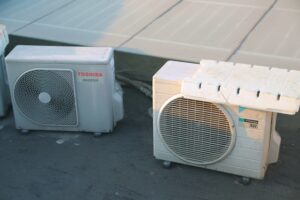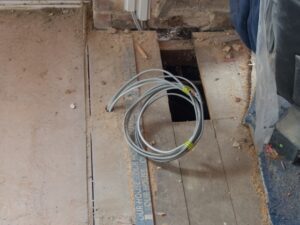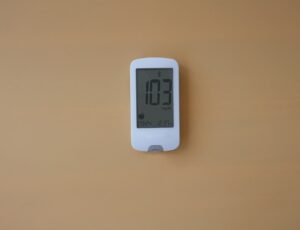We’ve all been there—just when you’re enjoying a warm shower or finishing up a dish, the water turns cold.
It’s not only annoying but can also throw off your whole day.
If you’ve noticed your hot water running out faster than usual, it might be a sign that something’s not quite right with your water heater. The culprit could be anything from the system’s age, sediment buildup, or even malfunctioning parts.
Whether it’s your water heater’s efficiency, the buildup of mineral deposits, or a thermostat issue, there are fixes that can restore your hot water flow. Addressing these concerns quickly can prevent bigger issues down the road, saving you time, money, and lots of cold showers.
But don’t worry, we’re here to guide you!
If you need expert help, Excel Mechanical is just a call away. Our team of HVAC and plumbing professionals is dedicated to providing quality, personalized solutions to keep your water heater working as it should.
In this blog, you will learn:
- Common reasons why your hot water might not be lasting as long as it used to.
- Effective solutions to fix the issue, from maintenance to upgrading your system.
- Tips for keeping your water heater efficient and extending its lifespan.
Ready to get that hot water flowing?
Let’s explore what might be going wrong.
Understanding Water Heating Systems
Water heating systems come in various types, each with unique components that affect performance and efficiency. Understanding these elements can help you make informed choices about maintenance and upgrades.
Types of Water Heaters
Water heaters are primarily of three types: tank, tankless, and heat pump models.
- Tank water heaters are the most common, storing heated water in a large reservoir. They can be cost-effective but may run out of hot water if usage spikes.
- Tankless water heaters heat water on demand, providing an endless supply without storage. They are energy efficient but could have higher upfront costs.
- Heat pump water heaters are another option, pulling heat from the air to warm the water. These systems are eco-friendly and can significantly lower energy usage but might not suit colder climates.
Each type has advantages depending on household size, hot water demand, and efficiency requirements.
Components of a Water Heater
A water heater consists of several key components.
- The heating element or burner is crucial for raising water temperature. Electric heaters use coils, while gas models have burners.
- Thermostats control the temperature, ensuring it remains within the desired range.
- The tank itself (in tank models) is insulated to maintain warmth. Heat exchangers are used instead for tankless systems. Anode rods are found within tanks to prevent corrosion by attracting minerals.
Proper maintenance of these components, like regularly flushing the tank to remove sediment, is essential to enhance lifespan and efficiency.
Common Issues with Hot Water Supply
If your hot water doesn’t last as long as it used to, there are a few common issues to consider.
Problems like sediment buildup, faulty heating elements, and thermostat malfunctions can all affect your hot water supply.
Let’s discuss them one by one!
Sediment Buildup
Sediment buildup occurs when minerals settle at the bottom of your water heater tank.
Over time, this layer can grow thicker, reducing the tank’s capacity to hold hot water. The heating efficiency is compromised because the burner must work harder to heat water through the sediment.
You might hear popping noises when the heater is on, indicating sediment presence. To address this, regular flushing of the tank is recommended to remove the buildup and restore efficiency.
Heating Element Failure
The heating element in an electric water heater can fail, resulting in lukewarm water instead of hot water. Elements may burn out or become coated with mineral deposits, preventing them from heating effectively.
If you notice your water isn’t getting hot enough, it could be due to a faulty element. Testing and replacing the heating element can resolve the issue.
Thermostat Problems
The thermostat controls the water temperature in your heater.
If it malfunctions, you might experience inconsistent water temperatures. Depending on the setting issue, a faulty thermostat can cause water to be too hot or not hot enough.
Your first step should be to check the thermostat settings. If necessary, adjust or replace it to correct the temperature problems.
Troubleshooting Steps
Addressing water heating issues involves inspecting and maintaining your water heater, resetting it, and periodically flushing the tank to remove buildup.
These steps can help restore hot water duration and improve efficiency.
Inspection and Maintenance
Begin by inspecting the water heater components.
Check the thermostat setting, ensuring it’s no higher than 120°F to prevent damage or hazards. Look over the heating elements for signs of wear, such as scaling or rust, which might affect performance.
Checking the anode rod is also vital, as this part prevents corrosion inside the tank.
If the rod appears heavily corroded, replacing it can help extend the life of your water heater. Regular maintenance ensures that minor issues are addressed before they become more significant problems.
Ensuring your system is functioning efficiently not only prolongs its lifespan but also enhances safety and comfort in your home or business.
Resetting the Water Heater
Sometimes, a simple reset can solve many heating issues.
Switch off the unit’s power from the breaker box for electric water heaters. Wait a few minutes, then turn it back on. This process can help resolve electrical glitches or minor thermostat malfunctions.
Gas water heaters often have a reset button near the thermostat. Pressing it might restore the system to working order. Resetting is particularly effective if the system has overheated or tripped a safety feature.
Consulting Excel Mechanical ensures professional guidance and peace of mind for any persistent issues, allowing you to focus on convenience and quality with experienced support.
Flushing the Tank
Flushing the tank periodically is essential to remove sediment buildup, which can affect heating efficiency and water quality. Sediment settles at the bottom of the tank, reducing the heater’s ability to maintain water temperature.
To flush the tank, first turn off the power and water supply. Attach a hose to the drain valve and direct the water to a suitable drainage area. Open the valve to release water and sediment. Let the water run clear before closing the valve and resuming operation.
Regular flushing assists in maintaining optimal performance, preventing issues that could require costly repairs or replacements.
Enhancing Water Heater Performance
Boosting your water heater’s efficiency can save energy and extend its lifespan.
Upgrading insulation, setting the optimal temperature, and installing a tank booster can improve performance and ensure a steady hot water supply.
Here are some ways to enhance your water heater’s performance:
Upgrading Insulation
Adding insulation to your water heater can significantly reduce heat loss. This is especially important if your heater is in a cold area like a garage or basement. One effective technique is to use an insulating blanket for the tank, which wraps around it to keep the heat in.
Insulating the pipes is also beneficial. This helps maintain water temperature as it travels to your faucets, reducing the need for reheating and saving energy.
Focus on insulating the first six feet of pipe from the heater.
Setting Optimal Temperature
Keeping the water heater temperature at an optimal level is crucial for efficiency. The usual recommendation is around 120 degrees Fahrenheit. This setting prevents overheating, reduces energy use, and minimizes the risk of scalding.
By keeping the temperature in check, you also slow down the buildup of minerals inside the tank, which can help maintain the system’s longevity. Frequent thermostat checking is essential to ensure it remains in the desired setting.
If you’re unsure about adjusting the temperature, professionals can assist. We aim to ensure your water heater operates at its best without wasting unnecessary energy.
Installing a Tank Booster
A tank booster can increase the capacity of your water heater without needing a larger tank. It mixes stored hot water with cold water before it reaches your faucets, allowing a higher output temperature without increasing the thermostat setting.
This results in more hot water availability from the same tank size. It’s an innovative solution for households frequently running out of hot water.
These enhancements can optimize your water heater’s performance, improving efficiency and hot water supply.
When to Call a Professional
Deciding when to involve an expert is crucial for efficient and cost-effective solutions.
Recognizing when issues are beyond DIY fixes and selecting a reliable technician are essential steps.
Let’s discuss when you should call a professional!
Recognizing Complex Issues
If your water heater is over ten years old or has persistent problems, it’s often time to call a professional. Issues like water heater leaks or inconsistent water temperature often need expert attention.
Repeated problems might indicate more complex issues, such as corrosion or significant wear. This is especially true if your water isn’t heating after attempts to resolve simple problems like adjusting thermostat settings. Also, unusual noises from your heater can signal serious internal issues.
Consulting with a professional can help prevent further damage and ensure proper functioning.
Choosing a Qualified Technician
When selecting a technician, ensure they have the necessary certifications and experience.
Look for reviews and, if possible, ask for recommendations from trusted sources. A qualified professional will efficiently diagnose and repair problems.
At Excel Mechanical, we provide exceptional HVAC and plumbing services, excelling in both residential and commercial needs. With a focus on quality and value, our team is dedicated to installing the best systems tailored to individual requirements and budgets.
By choosing us, you ensure a reliable solution prioritizing efficiency and cost-effectiveness.
Preventive Measures
Maintaining your hot water system can increase its efficiency and lifespan.
Regular care reduces unexpected breakdowns, saves energy, and ensures a steady hot water supply when needed.
Here are some preventive measures you must take:
Regular Maintenance Schedule
A routine maintenance schedule is essential for your hot water heater’s optimal function. One key task is to drain the tank regularly, which helps remove sediment buildup that can reduce heating efficiency. Consider doing this every six months.
Next, inspect the anode rod annually. This component prevents rust inside your tank. If it’s worn out, replace it promptly. Another critical step is to test the temperature-pressure relief valve. This ensures the system operates safely under pressure.
Regular checks help avoid leaks or, worse, lead to costly repairs.
Upgrading to a More Efficient Model
Sometimes, maintaining an old unit isn’t enough.
Upgrading to a more efficient model can be a smart move. Newer water heaters often use less energy while providing the same, if not better, performance. Choose tankless models if you’re looking for efficiency. They heat water only when needed, saving both water and energy.
Alternatively, consider heat pump water heaters. These use electricity to move heat from the air rather than generating it directly, making them more efficient than traditional electric water heaters.
Upgrading can seem costly initially. However, it can lead to significant savings on utility bills over time.
Long-Term Solutions
To address the issue of hot water not lasting as long as it used to, consider upgrading your system. Two effective options are switching to tankless water heaters and exploring solar water heating solutions.
Tankless Water Heaters
Tankless water heaters, also known as on-demand heaters, directly heat water without storing it. This means you get a continuous supply by heating water only when needed.
These units offer several benefits compared to traditional tank heaters. They are more energy-efficient, eliminating standby energy losses and potentially lowering your energy bill. These heaters also have a longer lifespan, lasting around 20 years with proper maintenance.
Installation can be more complex and costly, but the efficiency gains often make it worthwhile.
Solar Water Heating Options
Solar water heating systems use the sun’s energy to heat water in an eco-friendly way.
These systems consist of solar collectors and storage tanks. By reducing reliance on conventional energy sources, they significantly reduce utility bills and environmental impact.
There are two types of solar water heaters: active systems, which have circulating pumps and controls, and passive systems, which do not. While the initial cost can be high, tax incentives and reduced energy bills can offset expenses over time.
Frequently Asked Questions
Dealing with hot water issues can be frustrating, but understanding the common causes and solutions can help you tackle the problem effectively. Here are some of the most common questions homeowners have about why their hot water isn’t lasting as long as it used to:
What could be causing my shower to run out of hot water faster than normal?
Mineral buildup in your water heater tank can reduce its efficiency. A damaged dip tube or heating element can also lead to water heating inconsistencies.
Are there common reasons why my hot water heater is not providing as much hot water in the winter?
During colder months, incoming water takes longer to heat, straining your heater. Increased demand for hot water in winter could also reduce available hot water.
Why might my electric hot water heater suddenly deliver less hot water than it used to?
A faulty thermostat or a broken heating element may cause an electric water heater to provide less hot water. Sediment buildup can also lower efficiency.
What are the signs that a natural gas hot water heater may be failing to maintain its capacity?
If you notice rusty water or strange noises from your heater, it may signal a failing unit. A pilot light that won’t stay lit or fluctuations in water temperature can also be problematic.
How long does it typically take for a hot water heater to recover after running out of hot water?
Recovery time depends on your water heater type. An electric heater might take about an hour, while a gas unit typically recovers faster, often within 30 minutes.
What should I check if my hot water runs out after just 10 minutes?
Ensure the thermostat is correctly set and check for any faulty components. Insulating your pipes could help retain heat longer. If issues persist, consider seeking professional advice.




